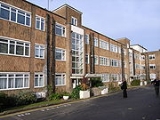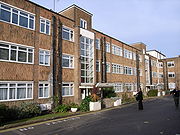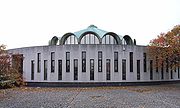
Frederick Gibberd
Encyclopedia
Sir Frederick Ernest Gibberd (7 January 1908 – 9 January 1984) was an English
architect
and landscape design
er.
Gibberd was born in Coventry
, the eldest of the five children of a local tailor, and was educated at the city's King Henry VIII School. In 1925 he was articled to a firm of architects in Birmingham
and studied architecture under William Bidlake
at the Birmingham School of Art
, where his room-mate was F. R. S. Yorke
.
A good friend of Sir Geoffrey Jellicoe
, Gibberd's work was influenced by Le Corbusier
, Mies van der Rohe, and F.R.S. Yorke. He set up in practice in 1930, designing Pullman Court, Streatham Hill, London (1934–6), a low-cost housing development which launched his career. With the success of this scheme, Gibberd became established as the 'flat' architect and went on to build several other schemes including Park Court, Sydenham, London (1936) and Ellington Court, Southgate, London (1936) continuing to practice until the outbreak of the Second World War.
Gibberd and Yorke collaborated on a number of publications including the influential book 'The Modern Flat' which was published in 1937 and featured the then newly completed Pullman Court and Park Court, as well as many other European examples.
He was consultant architect planner for the Harlow
development and spent the rest of his life living in the town he had designed. Notable works here include The Lawn, Britain's first modern-style point block, consisting of nine storeys arranged in a butterfly design on an area of open ground surrounded by oak trees; a tromp-l'oeil pair of curved terraces facing a cricket green at Orchard Croft, which won a British Housing Award in 1951; the pioneering broken-silhouette flats in Morley Grove; and much of the housing in Mark Hall neighbourhood, which is in its entirety a conservation area. The Harvey Centre lacks architectural distinction, but is notable as an early British example of a large purpose-built indoor shopping mall. His similary pioneering Sports Centre has been demolished, as has the original town hall. The Water Gardens, although listed by English Heritage
, have been spoilt by the abutment of a car park and shopping centre. The garden of his personal home at Marsh Lane, on the outskirts of Harlow, a mixture of formal and informal design, contains architectural elements salvaged from his reconstruction of Coutt's Bank in London.
A further achievement by Gibberd in planning Harlow is his incorporation of works by many leading architects of the post-war years, such as FRS Yorke, Powell & Moya, Graham Dawbarn, John Poulson
, Maxwell Fry
& Jane Drew
, Michael Neylan, William Crabtree
, Leonard Manasseh, ECP Monson, Gerard Goalen, Gerald Lacoste and Richard Sheppard. A substantial collection of public sculptures is visible around the town ,including works by Henry Moore
, Elizabeth Frink, Auguste Rodin
and Barbara Hepworth
.
Harlow is regarded as the most successful of Britain's post-war new towns and functions as an object lesson in modern architecture and town planning. Gibberd's book "Harlow: The story of a New Town", written in collaboration with Len White and Ben Hyde Harvey, is required reading for anyone with an interest in such matters.
In 1953 he published "Town Design," a book on the forms, processes, and history of the subject.
 A list of buildings by Frederick Gibberd:
A list of buildings by Frederick Gibberd:
England
England is a country that is part of the United Kingdom. It shares land borders with Scotland to the north and Wales to the west; the Irish Sea is to the north west, the Celtic Sea to the south west, with the North Sea to the east and the English Channel to the south separating it from continental...
architect
Architect
An architect is a person trained in the planning, design and oversight of the construction of buildings. To practice architecture means to offer or render services in connection with the design and construction of a building, or group of buildings and the space within the site surrounding the...
and landscape design
Landscape design
Landscape design is an independent profession and a design and art tradition, practised by landscape designers, combining nature and culture. In contemporary practice landscape design bridges between landscape architecture and garden design.-Design scope:...
er.
Gibberd was born in Coventry
Coventry
Coventry is a city and metropolitan borough in the county of West Midlands in England. Coventry is the 9th largest city in England and the 11th largest in the United Kingdom. It is also the second largest city in the English Midlands, after Birmingham, with a population of 300,848, although...
, the eldest of the five children of a local tailor, and was educated at the city's King Henry VIII School. In 1925 he was articled to a firm of architects in Birmingham
Birmingham
Birmingham is a city and metropolitan borough in the West Midlands of England. It is the most populous British city outside the capital London, with a population of 1,036,900 , and lies at the heart of the West Midlands conurbation, the second most populous urban area in the United Kingdom with a...
and studied architecture under William Bidlake
William Bidlake
William Henry Bidlake was an English architect, a leading figure of the Arts and Crafts movement in Birmingham and Director of the School of Architecture at Birmingham School of Art from 1919 until 1924....
at the Birmingham School of Art
Birmingham School of Art
The Birmingham School of Art was a municipal art school based in the centre of Birmingham, England. Although the organisation was absorbed by Birmingham Polytechnic in 1971 and is now part of Birmingham City University's Birmingham Institute of Art and Design, its Grade I listed building on...
, where his room-mate was F. R. S. Yorke
F. R. S. Yorke
Francis Reginald Stevens Yorke , known professionally as F. R. S. Yorke and informally as Kay or K, was an English architect and author....
.
A good friend of Sir Geoffrey Jellicoe
Geoffrey Jellicoe
Sir Geoffrey Jellicoe was an English landscape architect, garden designer, Architect and author.Jellicoe was born in Chelsea. He studied at the Architectural Association in London in 1919 and won a Rome Scholarship in 1923 which enabled him to research his first book Italian Gardens of the...
, Gibberd's work was influenced by Le Corbusier
Le Corbusier
Charles-Édouard Jeanneret, better known as Le Corbusier , was a Swiss-born French architect, designer, urbanist, writer and painter, famous for being one of the pioneers of what now is called modern architecture. He was born in Switzerland and became a French citizen in 1930...
, Mies van der Rohe, and F.R.S. Yorke. He set up in practice in 1930, designing Pullman Court, Streatham Hill, London (1934–6), a low-cost housing development which launched his career. With the success of this scheme, Gibberd became established as the 'flat' architect and went on to build several other schemes including Park Court, Sydenham, London (1936) and Ellington Court, Southgate, London (1936) continuing to practice until the outbreak of the Second World War.
Gibberd and Yorke collaborated on a number of publications including the influential book 'The Modern Flat' which was published in 1937 and featured the then newly completed Pullman Court and Park Court, as well as many other European examples.
He was consultant architect planner for the Harlow
Harlow
Harlow is a new town and local government district in Essex, England. It is located in the west of the county and on the border with Hertfordshire, on the Stort Valley, The town is near the M11 motorway and forms part of the London commuter belt.The district has a current population of 78,889...
development and spent the rest of his life living in the town he had designed. Notable works here include The Lawn, Britain's first modern-style point block, consisting of nine storeys arranged in a butterfly design on an area of open ground surrounded by oak trees; a tromp-l'oeil pair of curved terraces facing a cricket green at Orchard Croft, which won a British Housing Award in 1951; the pioneering broken-silhouette flats in Morley Grove; and much of the housing in Mark Hall neighbourhood, which is in its entirety a conservation area. The Harvey Centre lacks architectural distinction, but is notable as an early British example of a large purpose-built indoor shopping mall. His similary pioneering Sports Centre has been demolished, as has the original town hall. The Water Gardens, although listed by English Heritage
English Heritage
English Heritage . is an executive non-departmental public body of the British Government sponsored by the Department for Culture, Media and Sport...
, have been spoilt by the abutment of a car park and shopping centre. The garden of his personal home at Marsh Lane, on the outskirts of Harlow, a mixture of formal and informal design, contains architectural elements salvaged from his reconstruction of Coutt's Bank in London.
A further achievement by Gibberd in planning Harlow is his incorporation of works by many leading architects of the post-war years, such as FRS Yorke, Powell & Moya, Graham Dawbarn, John Poulson
John Poulson
John Garlick Llewellyn Poulson was a British architect and businessman who caused a major political scandal when his use of bribery was disclosed in 1972. The highest-ranking figure to be forced out was Conservative Home Secretary Reginald Maudling...
, Maxwell Fry
Maxwell Fry
Edwin Maxwell Fry, CBE, RA, FRIBA, FRTPI, known as Maxwell Fry , was an English modernist architect of the middle and late 20th century, known for his buildings in Britain, Africa and India....
& Jane Drew
Jane Drew
Dame Jane Drew, DBE, FRIBA was an English modernist architect and town planner. She qualified at the AA School in London, and prior to World War II became one of the leading exponents of the Modern Movement in London....
, Michael Neylan, William Crabtree
William Crabtree
William Crabtree was an astronomer, mathematician, and merchant from Broughton, then a township near Manchester, which is now part of Salford, Greater Manchester, England...
, Leonard Manasseh, ECP Monson, Gerard Goalen, Gerald Lacoste and Richard Sheppard. A substantial collection of public sculptures is visible around the town ,including works by Henry Moore
Henry Moore
Henry Spencer Moore OM CH FBA was an English sculptor and artist. He was best known for his semi-abstract monumental bronze sculptures which are located around the world as public works of art....
, Elizabeth Frink, Auguste Rodin
Auguste Rodin
François-Auguste-René Rodin , known as Auguste Rodin , was a French sculptor. Although Rodin is generally considered the progenitor of modern sculpture, he did not set out to rebel against the past...
and Barbara Hepworth
Barbara Hepworth
Dame Barbara Hepworth DBE was an English sculptor. Her work exemplifies Modernism, and with such contemporaries as Ivon Hitchens, Henry Moore, Ben Nicholson, Naum Gabo she helped to develop modern art in Britain.-Life and work:Jocelyn Barbara Hepworth was born on 10 January 1903 in Wakefield,...
.
Harlow is regarded as the most successful of Britain's post-war new towns and functions as an object lesson in modern architecture and town planning. Gibberd's book "Harlow: The story of a New Town", written in collaboration with Len White and Ben Hyde Harvey, is required reading for anyone with an interest in such matters.
In 1953 he published "Town Design," a book on the forms, processes, and history of the subject.
Notable buildings
- HarlowHarlowHarlow is a new town and local government district in Essex, England. It is located in the west of the county and on the border with Hertfordshire, on the Stort Valley, The town is near the M11 motorway and forms part of the London commuter belt.The district has a current population of 78,889...
New Town - London Central MosqueLondon Central MosqueThe London Central Mosque is a mosque in North London, England. It was designed by Sir Frederick Gibberd, completed in 1978, and has a prominent golden dome. The main hall can hold over five thousand worshippers, with women praying on a balcony overlooking the hall...
- Liverpool Metropolitan CathedralLiverpool Metropolitan CathedralThe Metropolitan Cathedral Church of Christ the King is a Roman Catholic cathedral in Liverpool, Merseyside, England. The cathedral is the seat of the Archbishop of Liverpool and the Roman Catholic Archdiocese of Liverpool. The Metropolitan Cathedral is one of two cathedrals in the city...
- Didcot Power StationDidcot Power StationDidcot Power Station refers to a combined coal and oil power plant and a natural-gas power plant that supply the National Grid. They are situated immediately adjoining one another in the civil parish of Sutton Courtenay, next to the town of Didcot in Oxfordshire , in the UK...
, Oxfordshire, England

- 1933–1936, Pullman Court, Streatham, London
- 1936, Park Court, Sydenham, London
- 1937, Ellington Court, Southgate, London
- 1937–1939, Macclesfield Nurses Home, Cheshire, England
- 1945–1949, Somerfield Estate, Hackney, London
- 1946–1963, Nuneaton Town Centre, Warwickshire, England
- 1949–1951, Chrisp Street MarketChrisp Street MarketChrisp Street Market was designed by Frederick Gibberd, and built as part of the Festival of Britain in 1951. It is located in Poplar in the London Borough of Tower Hamlets, and forms part of the eastern edge of the Lansbury Estate....
and associated housing, Poplar, LondonPoplar, LondonPoplar is a historic, mainly residential area of the East End of London in the London Borough of Tower Hamlets. It is about east of Charing Cross. Historically a hamlet in the parish of Stepney, Middlesex, in 1817 Poplar became a civil parish. In 1855 the Poplar District of the Metropolis was...
(part of the Lansbury EstateLansbury EstateThe Lansbury Estate is a public housing estate in the Poplar area of the London Borough of Tower Hamlets named after George Lansbury, a Poplar councillor and Labour party MP.It is one of the largest such estates in London...
) - 1950 Orchard Croft Housing Estate & The Stow (Shopping centre), Harlow, Essex, England
- 1950–1969, Terminal Buildings, Heathrow Airport, near London
- 1951, The Lawn, Harlow, Essex, England
- 1952, Market Square, Harlow, Essex, England
- 1953–1961, Ulster Hospital, Belfast
- 1956, Bath Technical College, Somerset, England
- 1956–1968, Civic Centre, Saint Albans, Hertfordshire, England
- 1958, Derwent ReservoirDerwent Reservoir, North East EnglandDerwent Reservoir is a reservoir on the River Derwent, on the border between County Durham and Northumberland, in England. It is west of Consett....
, Durham and Northumberland, England - 1958, The Beckers, Rectory Road, Hackney, London
- 1959–1969, Civic Centre, Doncaster, Yorkshire, England
- 1962, College of Technology, Kingston-Upon-Hull, England
- 1959–1968, Fulwell Cross Library, Ilford
- 1960–1966, Priory SquareMartineau GalleriesMartineau Galleries is an important proposed mixed-use development for Birmingham, England as it will connect the Eastside to the city centre core and is also located on the High Street, a major retail area.- Pre-1960s development :...
, Birmingham, England
- 1960–1967, Roman Catholic CathedralLiverpool Metropolitan CathedralThe Metropolitan Cathedral Church of Christ the King is a Roman Catholic cathedral in Liverpool, Merseyside, England. The cathedral is the seat of the Archbishop of Liverpool and the Roman Catholic Archdiocese of Liverpool. The Metropolitan Cathedral is one of two cathedrals in the city...
, Liverpool, England - 1961, Morley Grove Flats, Harlow, Essex, England
- 1962–1966, Douai AbbeyDouai AbbeyDouai Abbey is a Benedictine Abbey at Woolhampton, near Thatcham, in the English county of Berkshire, situated within the Roman Catholic Diocese of Portsmouth. Monks from the monastery of St. Edmund's, in Douai, France, came to Woolhampton in 1903 when the community left France as a result of...
, Berkshire, England - 1964, Saint George's Chapel, Heathrow Airport, near London
- 1964, Water Gardens, Harlow, Essex, England
- 1965, Chapel, De La Salle College, Middleton, Manchester, England
- 1964–1968, Didcot Power StationDidcot Power StationDidcot Power Station refers to a combined coal and oil power plant and a natural-gas power plant that supply the National Grid. They are situated immediately adjoining one another in the civil parish of Sutton Courtenay, next to the town of Didcot in Oxfordshire , in the UK...
, Oxfordshire, England - 1965–1974, Edmonton Green, Edmonton, London
- 1966–1975, Arundel Great Court, The Strand
- 1968–1975, Inter-Continental Hotel, Hyde Park Corner; London
- 1969, Coutts Bank Headquarters, London, England
- 1970–1977, London Central MosqueLondon Central MosqueThe London Central Mosque is a mosque in North London, England. It was designed by Sir Frederick Gibberd, completed in 1978, and has a prominent golden dome. The main hall can hold over five thousand worshippers, with women praying on a balcony overlooking the hall...
- 1980, The Harvey Centre, Harlow, Essex, England

